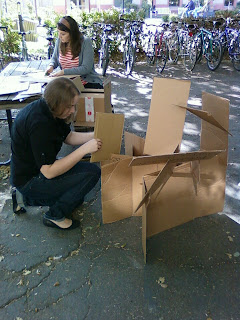Over the years many companies decide to make changes to their logos in order to appeal to the consumer. Some companies decide to change their logos completely but others decide to just make some minor adjustments while still preserving the old format. In order for a new logo to be effective one must always consider what elements worked from that old logo and keep them in the new logo. Take for example the retro burger king logo.
 |
| Image from: http://dadsdish.blogspot.com/2010/05/older-is-better-example-124-restaurant.html |
This logo shows some simplicity because there are just two buns and between them there are the words Burger King. The words and the buns show a form of unity and a feeling of harmony. Together they form a hamburger which is what Burger King sells. This is a relatively efficient logo because it both resembles the product but at the same time has the name of the company within the logo. This retro Burger King logo is two dimensional in that there are no shadows and other elements that would give it a three dimensional look. Keeping this in mind now take a look at the new Burger king logo.
 |
| Image from: http://dadsdish.blogspot.com/2010/05/older-is-better-example-124-restaurant.html |
The new BK logo has more contrast then the old logo. Part of it is that the buns are lighter and this makes the words Burger King stand out more. Another reason why it has higher contrast is that this new logo has almost a full blue circle around the whole logo which really grabs your attention. Adding the highlights to the buns really make this logo look more three dimensional. These buns pop off the page more than the buns from the older logo. The new BK logo isn’t completely different than the old one and one reason why it must have remained almost the same was because of the unity. The old logo does a great job in that all the elements look like they belong together.
One major difference that we see from looking at these two logos is that the letters are slanted in the newer version of the BK logo. Part of the reason this occurred was because a lot of the updated versions of major food chain logos are slanted. If you notice most of the following logos are slanted as opposed to before when they were not. So when BK changed their logo they also were taking into consideration the logos of other major food chains. Fitting in with other logos is important because it demonstrates that they are also a major food chain. It is also important to stand out that way the consumer will easily recognize their logo where ever they are. BK did a great job in redesigning their new logo because they kept there old format but updated it to resemble the present.
 |
| Image from: http://www.retrojunk.com/details_articles/3061/ |












